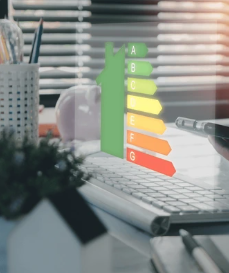Grant and Energy Saving Advice
To find out if you’re eligible for free home energy efficiency upgrades using ECO4 or GBIS funding, you can complete our simple online eligibility check, or you can give one of our friendly team a call and they will be pleased to discuss this with you 01733639292.
Alternatively, if you would like to find out more about ECO4 or GBIS, you can contact your energy supplier or
About ECO4
The Energy Company Obligation (ECO) is a government-mandated initiative overseen by Ofgem and delivered by obligated energy suppliers across England, Scotland, and Wales. Launched in 2013, the scheme is now in its fourth phase (ECO4), following a series of updates aimed at better supporting households facing fuel poverty and reducing carbon emissions from homes.

Do I qualify for ECO4?
ECO4 is designed to help the most vulnerable households living in the least energy-efficient homes. Eligibility is means-tested, with criteria set by the UK government.
To determine if you qualify, we first need to know how your home is heated. ECO4 mainly targets households that do not use gas heating. However, if your home is heated by gas but has an old boiler—typically one installed before 2012—you may still be eligible, as older boilers are generally inefficient.
We also need to know if you or anyone in your household receives a means-tested benefit, as this is a key part of the qualification process.
• Housing Benefit
• Income based Jobseekers Allowance
• Income related Employment Support Allowance
• Income Support
• Pension Credit – Guarantee Credit
• Pension Credit – Savings Credit
• Universal Credit
• Working Tax Credit

If no one in your household receives one of the qualifying benefits, you may still be eligible through an alternative route known as LA Flex. This option allows your local authority to assess and confirm your eligibility for the scheme.
To qualify under LA Flex, your total household income must be under £31,000 per year, including the income of all adults living in the home. Alternatively, if you or someone in your household has a health condition that makes them particularly vulnerable to cold temperatures, you may also qualify.
Determining eligibility can sometimes be complex, but we’re here to guide and support you through the process. If someone in your home receives a qualifying benefit, this can typically be confirmed quickly via the Energy Saving Trust. For LA Flex applications, we’ll need to gather supporting documents from all adults in the household. This includes a copy of your council tax bill, and may also involve payslips, bank statements, P60s, or a letter from a medical professional.
What can I get through ECO4 funding?
ECO4 is a multi-measure scheme designed to improve your home’s comfort, warmth, and energy efficiency by carrying out insulation work and, where possible, upgrading your heating system. To reduce heat loss, it’s essential to insulate key areas such as your roof and walls. In most cases, we’re unable to upgrade your heating system unless the necessary insulation improvements have been made first.
Up to 25% of heat can be lost through uninsulated roof spaces. Therefore, it is recommended to have at least 300mm of loft insulation—roughly the length of an A4 sheet of paper—and to ensure that any flat roofs or rooms within roof spaces are properly insulated.
If you have converted your loft into a living area, the room should be insulated. This is typically done by fitting insulation boards or quilted insulation onto the external walls inside the room, which is then covered with plasterboard and finished with a plaster skim to create a smooth surface ready for decorating.
Up to 20% of heat can be lost through uninsulated walls, so insulating walls is recommended to reduce this heat loss.
Insulation boards or quilted insulation are installed on the external walls inside your home, then covered with plasterboard and finished with a plaster skim to create a smooth surface ready for redecorating.
Solar panels are mounted on your roof and can generate energy throughout the year, including on cloudy days. To maximize the benefits of your solar PV system, it’s best to use appliances like the washing machine, tumble dryer, and dishwasher during the day when your panels are producing energy.
If your home has a central heating system, it should be equipped with a complete set of heating controls, which includes:
Thermostatic Radiator Valves (TRVs) that let you control the heat output of each radiator individually.
A programmer and room thermostat that allow you to schedule your heating to turn on at different times and temperatures, and to adjust the temperature as needed.
A bypass radiator, which safeguards your heating system by ensuring that at least one radiator remains on to keep the system functioning properly.
Quilted loft roll is laid in your loft to a depth of about 300mm—approximately the length of an A4 sheet of paper. This insulation forms a barrier between the living area and the roof space, helping to slow the escape of warm air and keep your home warmer.
If your home has flat roofs that are structurally sound, we can insulate them by fitting insulation boards to the external surface, followed by sealing and weatherproofing the roof area.
Polystyrene insulation is injected into the cavity between the inner and outer walls through small holes drilled into the external brickwork of your home and secured in place using a special adhesive.
An air source heat pump, connected to your home’s radiators, serves as a central heating system by working like a refrigerator in reverse. It extracts heat from the outside air, even at temperatures as low as -27°C. These pumps operate on electricity and are typically installed alongside solar PV systems for optimal efficiency.
If your home uses outdated electric storage heaters, we can replace them with new, high-heat-retention, energy-efficient models. These modern heaters require less energy to charge, making your home more efficient and easier to warm.
About GBIS
The Great British Insulation Scheme (GBIS) is a government-funded program aimed at improving home energy efficiency by focusing on insulating properties across England, Scotland, and Wales. Unlike ECO4, GBIS supports the installation of a single insulation measure, such as wall or roof insulation, and is available to both homeowners and private tenants.
Similar to ECO, if someone in the household receives a means-tested benefit and the property falls within council tax bands A to E, you are likely eligible. Below is a list of qualifying benefits:
• Child Tax Credit
• Housing Benefit
• Income based Jobseekers Allowance
• Income related Employment Support Allowance
• Income Support
• Pension Credit – Guarantee Credit
• Pension Credit – Savings Credit
• Universal Credit
• Working Tax Credit

You could also qualify for GBIS is you own your home, your council tax band is between A and E, and if your EPC energy rating is D, E, F, or G. If your home is in England or Wales, you can
popping in your postcode and searching for your address in the database.
If your home is in Scotland, you can scroll to the bottom of the page to accept the terms and conditions and select ‘continue’. You can then untick Non-domestic, pop in your postcode and the text in the image and click search.
Similarly to ECO4, GBIs is administered by Ofgem and managed by the energy companies. You could have cavity wall or internal wall insulation installed, or loft or flat roof insulation.
